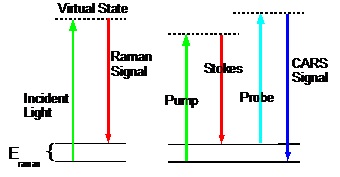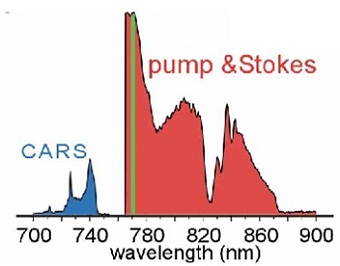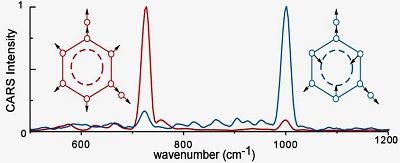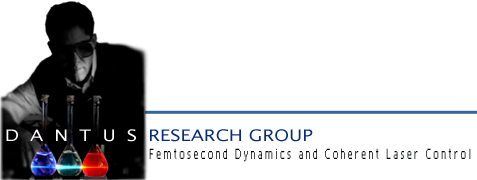

This schematic for single beam CARS shows how the pump, stokes, and probe are cut from the spectrum of a femtosecond laser. The CARS signal appears on the blue side of the spectrum which excludes any single photon fluorescence. The far weaker CARS signal intensity is greatly exaggerated here to simultaneously display it with the laser spectrum.

Unprocessed CARS spectra from m-xylene with two specially designed binary phases. The designed binary phases control the ratio between the two Raman peaks with an overall two order-of-magnitude discrimination from 7:1 to 1:12. Opt. Express 16, 5499-5504 (2008)
Nonlinear Optics, Quantum Control and Sensing
CARS (Coherent anti-Stokes Raman Scattering):
CARS is a four wave mixing process that can be used to observe the vibrational energy levels of molecules. In Raman spectroscopy, a small fraction of incident photons are scattered and shifted in frequency. This frequency corresponds to the change in vibrational energy of the sample. CARS is similar in that the blue shift of the incident beam (probe) corresponds to the vibrational energy, however the excited population is due to the pump and Stokes. This is a coherent excitation and results in a coherent CARS signal which has a quadratic dependence on molecule number, and a cubic dependence on total incident intensity. The difference is diagramed at right.
The main interest in our group is on single beam CARS using a femtosecond laser. In this approach, the broad bandwidth of the ultrafast laser is used as the pump, Stokes and probe, eliminating the hassle of overlapping three beams in space and time. Furthermore, the broad bandwidth of the laser can excite all the Raman active levels of an unknown sample simultaneously, making chemical determination by the unique vibrational spectrum possible. The ultrashort pulses also have the extremely high fields necessary for the non-linear process.
Pulse shaping offers the ability to control coherent processes. One example is using the phase of the different frequency components to selectively excite certain Raman modes in CARS experiments.
Publications: 170, 163, 161, 160, 156, 146, 144, 134, 132, 127, 118
